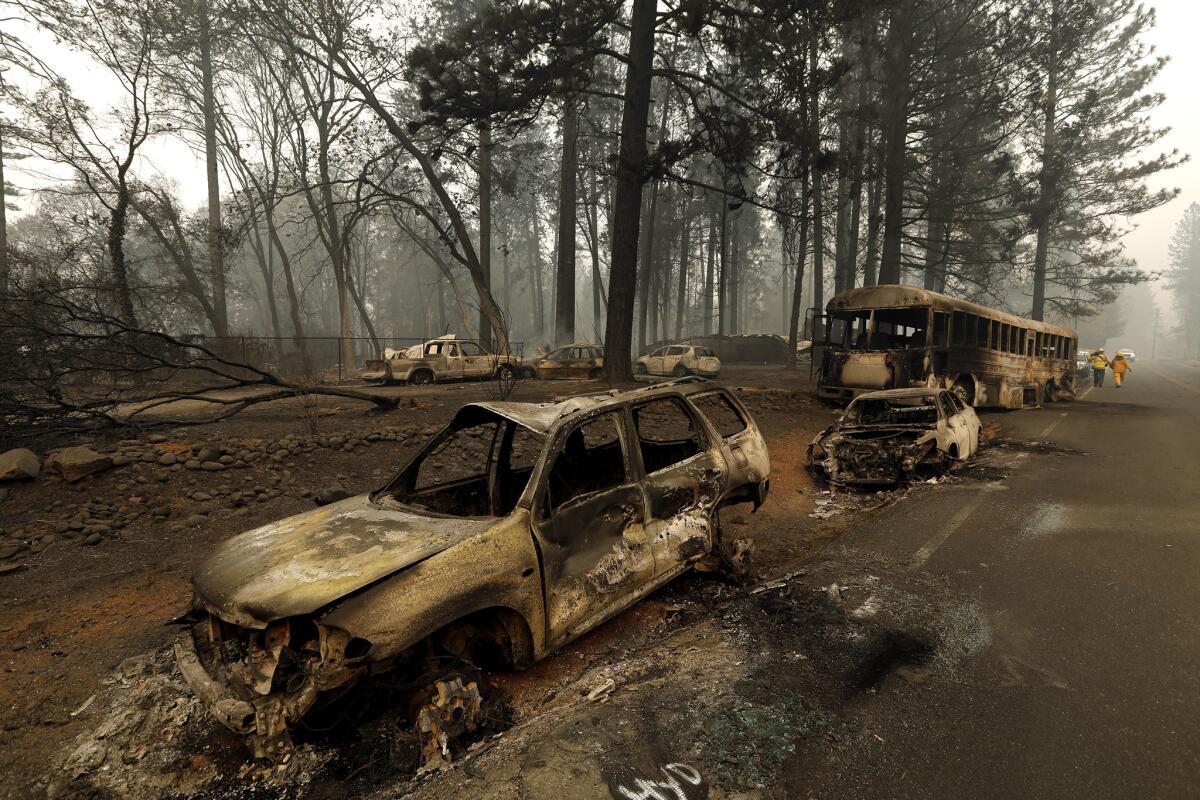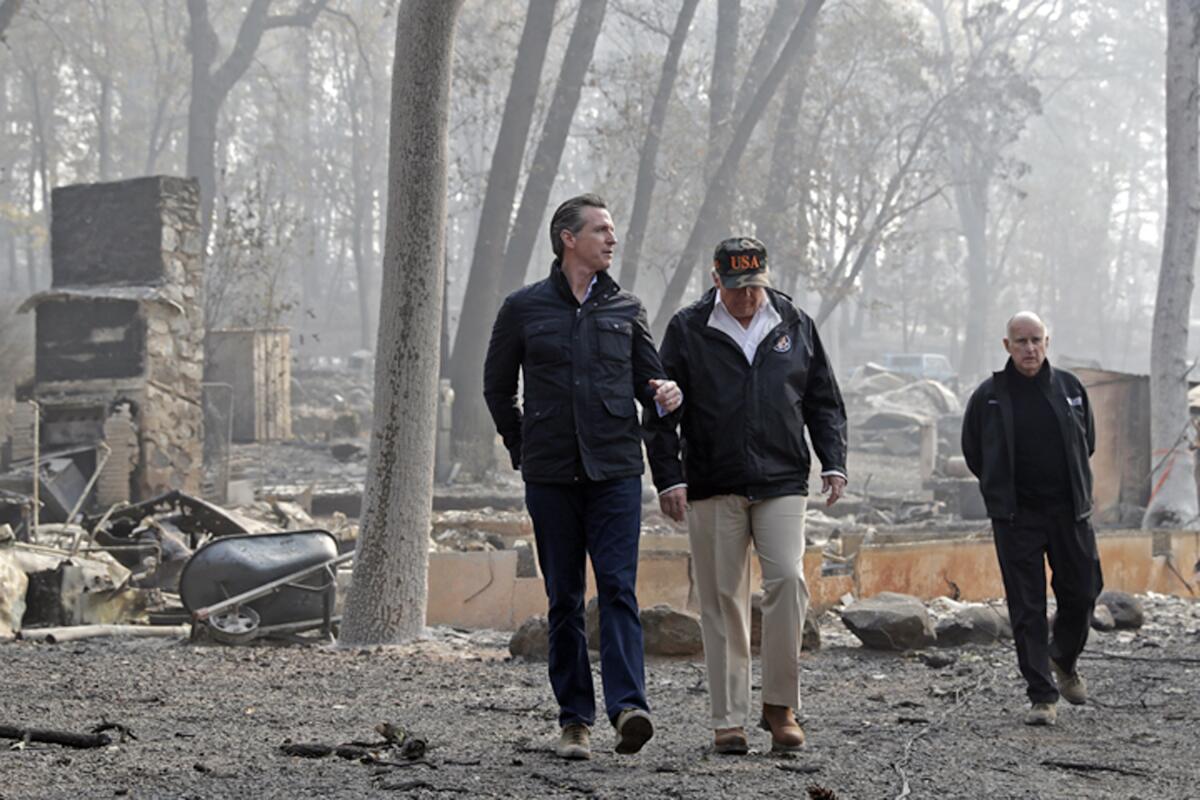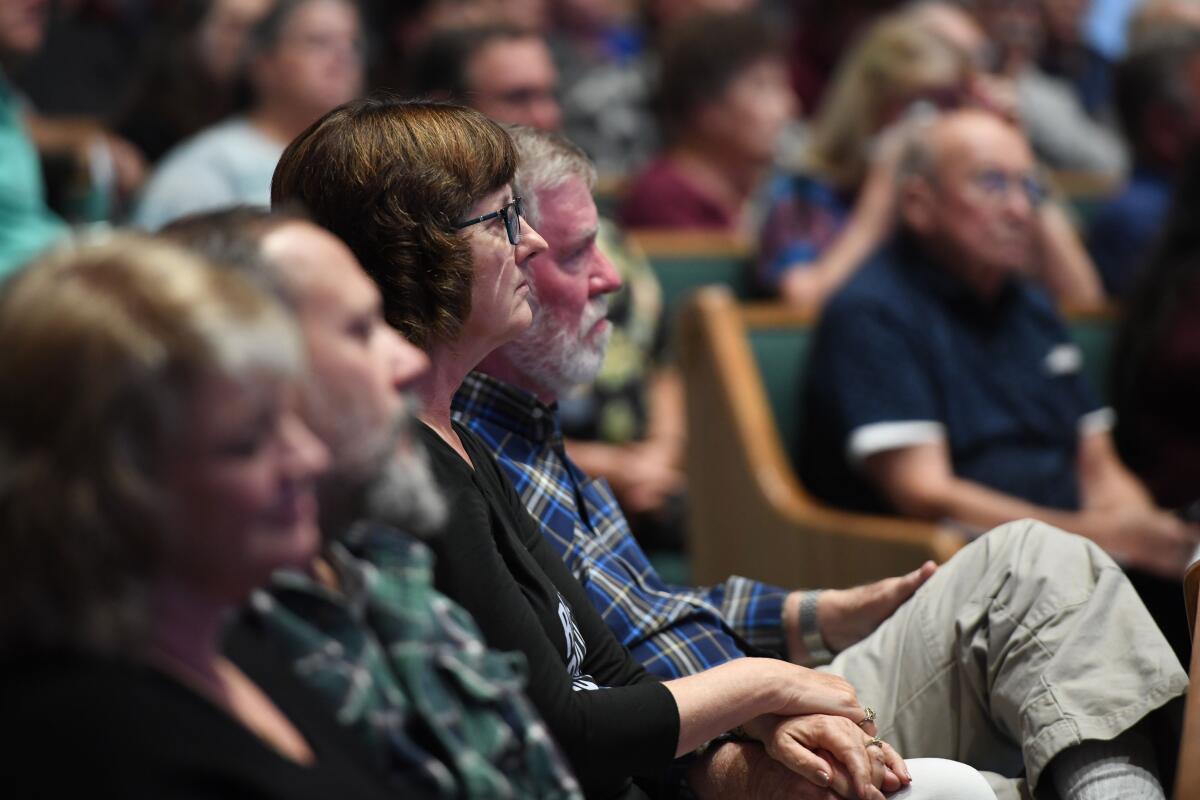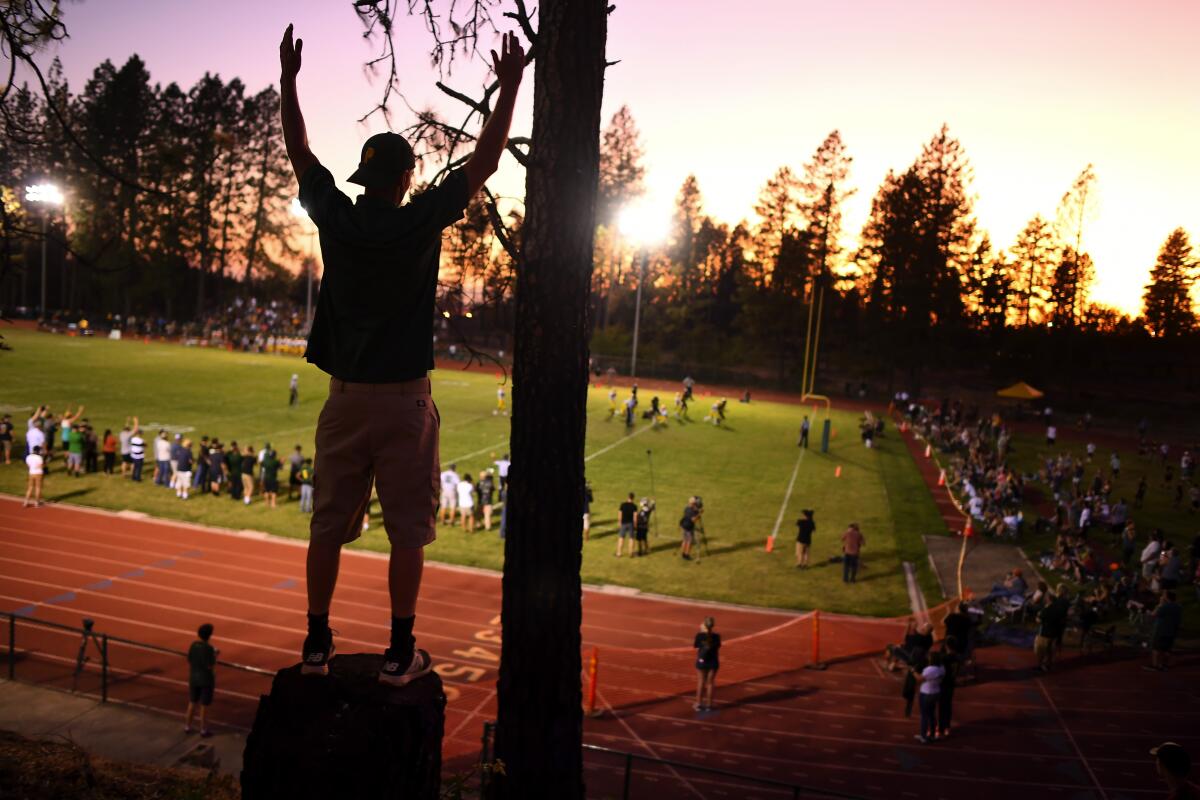A year after Paradise fire, California lawmakers hope to keep history from repeating

- Share via
SACRAMENTO — A year ago, Billie and Scott Salsbury were stuck in their car, unable to move on a road surrounded by flames.
“All we could hear is explosions around us,” Scott Salsbury said, describing the panic and anxiety his family experienced as they evacuated the town of Paradise during the Camp fire last November.
The Salsburys survived a scenario officials hadn’t planned for: thousands of residents fleeing at the same time from a town overcome by wildfire — and with few ways to get out. Many others perished in their cars, killed in the blaze that ultimately took 85 lives.
A dire need for better evacuation routes was just one hard lesson of the Camp fire, a tragedy that prompted California’s elected officials to try to prevent history from repeating itself.

“Upon hearing the news and seeing the destruction, you understood immediately that the fire would change the way we see wildfires and their potential for loss of life,” Gov. Gavin Newsom said. “The fire also made clear that California needed to do better across the board, from preparedness to response and recovery.”
In the year since, the governor and California Legislature pushed through laws requiring cities and counties to identify inadequate evacuation routes in residential developments built in hazard zones, and increased funding to update the 911 system and reduce the kinds of vegetation that fueled the Camp fire. But other bills to address politically fraught issues fizzled in the Legislature, were vetoed or dramatically scaled back.
Driven by disaster, wildfire was at the top of the Legislature’s list of priorities as it started 2019, and a series of events forced lawmakers to broaden their focus and consider much more than prevention.
Two days after Newsom was elected to succeed Jerry Brown as governor, a Pacific Gas & Electric transmission line sparked the Camp fire. One week after Newsom was sworn into office in January, PG&E, the state’s largest utility, announced that it intended to file for bankruptcy. And by midsummer, thousands of Californians were coping with blackouts as utilities across the state turned off power in an attempt to prevent equipment from sparking blazes, a practice that drew ire from ratepayers and lawmakers alike.
The first six months of the legislative year were marked by executive action as the Newsom administration hatched a plan to address wildfire liability. Lawmakers pressed forward with proposals to better prepare the state for disaster.
The governor declared a preemptive state of emergency in March and waived environmental regulations to expedite nearly three dozen local forest management projects to protect communities from wildfires. Newsom redirected California National Guard troops from the border to help the state Department of Forestry and Fire Protection begin prevention work and called up an extra 400 seasonal firefighters earlier than usual. The state was also given authority from the U.S. secretary of Defense to fly the National Guard’s unmanned aerial equipment to help map active fires.
The budget signed into law by Newsom in June envisioned a sweeping response to the crisis — nearly a billion dollars for local, regional and state efforts to prepare, respond to and prevent wildfires. In addition to the funding to update the 911 system, the money included $67.5 million to boost firefighting and $127.2 million for new air tankers and helicopters to improve aerial attacks. The administration also provided permanent funding to position fire equipment in areas of the state where extreme conditions are anticipated so firefighters can access and fight blazes more quickly.
Communities ravaged by fire received $31.8 million to recoup property tax revenue, a significant concern for towns that have been wiped out by blazes and whose residents have been displaced. Another $28.8 million was dedicated to recovery, with an additional $10 million directed specifically to Camp fire efforts.

Jody Jones, the mayor of Paradise, commended the state for boosting local recovery, but cautioned that unwinding decades of problems that led to the wildfire crisis will take years to achieve. The legislative process in Sacramento is not designed for swift action — lawmakers introduce bills at the start of the year, but most legislation approved and enacted into law by the governor doesn’t take effect until the following January.
“A year is a short period of time for recovery from a disaster like this, and the problems have been allowed to grow and grow for so long that the solutions are not going to be simple or cheap,” Jones said.
Under pressure from Wall Street, the Newsom administration pushed lawmakers to approve a law in early July to create a multibillion-dollar wildfire fund that utilities could tap into to pay damages, propped up by $10.5 billion from ratepayers and another $10.5 billion from companies.
“It was a necessary conversation and legislation that needed to happen in order to provide some stability to the utility network and also create the additional safety requirements,” said Cara Martinson, a lobbyist for the California State Assn. of Counties. “It’s unfortunate that we had to do that two years in a row. I don’t think there was any way around it.”
As a condition of using the fund, all utilities will have to comply with new safety requirements and PG&E must settle claims with wildfire victims and exit bankruptcy by June 30, without raising rates on customers. The law also establishes a wildfire safety division at the California Public Utilities Commission, advised by a panel of experts, to ensure that utilities are operating safe systems.

Assemblyman James Gallagher (R-Yuba City) said he begrudgingly voted for the bill, reluctant to help a company that he said had failed to prioritize safety.
“I was very torn by it,” said Gallagher, who represents the Paradise area. “I felt like PG&E obviously wasn’t doing what it needed to be doing and PUC oversight wasn’t what it should’ve been. But the other issue is, are you going to leave victims hanging and do you leave the IOUs in a really unstable situation that could have a rippling effect?”
By the end of the legislative session in September, lawmakers approved several more wildfire bills.
A new law introduced by state Sen. Bill Dodd (D-Napa) requires the state fire marshal to develop a model defensible-space program for communities, an effort aimed at removing flammable vegetation on properties that can quickly spread fire to homes. Another Dodd bill requires the PUC to perform audits of vegetation management work completed by the utilities.
Another law requires investor-owned utilities to consider the expensive and time-consuming act of moving power lines underground to prevent contact with trees that cause fires, while stronger legislation to require utilities to begin the work fell flat.
Lawmakers in areas that had already experienced power shutoffs to prevent wildfires pushed through new laws to mitigate the effects on vulnerable communities and require utilities to notify emergency managers before outages take place.
Other legislation to address some of the most stubborn, politically challenging and expensive problems — including where and how people build homes — was met with resistance.
Assemblyman Jim Wood (D-Healdsburg) introduced legislation less than a month after the Camp fire that would have created a $1-billion loan fund to help eligible homeowners install fire-resistant vents, roofs, eaves and windows and meet existing requirements to trim trees and vegetation within 100 feet of their homes. Legislators were unwilling to approve legislation with such a high price tag, forcing Wood to completely retool the proposal, instead directing state agencies to develop a pilot program to retrofit homes and create statewide home-hardening standards. No funding was attached to the bill.
Fireproofing homes in vulnerable communities is critical to preventing the spread of wildfire in California, said Max A. Moritz, a wildfire specialist with the UC Cooperative Extension and an adjunct professor at UC Santa Barbara’s Bren School of Environmental Science & Management. Moritz said too much of the political conversation has instead been focused on reducing fuels.
“If you go back and look at Paradise, look at Santa Rosa, it’s the homes that were burning,” he said. “It becomes a home-to-home spread. The homes were the fuel. One billion dollars is a tiny drop in the bucket, and it could have huge positive repercussions.”
Newsom vetoed legislation to expand defensible-space laws and require homeowners in the state’s highest-risk areas to develop a 5-foot ember-resistant zone around homes. In his veto message, the governor repeated a California political mantra that has long frustrated wildfire experts: Local communities, not the state, should be allowed to decide what works best for them.
“Each community is different and best practices to achieve resiliency need to be created to meet the individual needs of that community,” Newsom wrote.
Legislation to reduce development requirements in very high fire risk areas also faltered late in the year, caught in the crossfire between advocates for the bill and proponents of affordable housing.
Martinson and others expect lawmakers to renew their efforts to prevent wildfires and harden homes next year, while focusing more attention on utility power shut-offs.
“I think Paradise and the fires of 2017 were a huge wake-up call for California,” Martinson said. “We’ve made good progress, but we’ll have years before we’re going to be where we need to be.”
More to Read
Sign up for Essential California
The most important California stories and recommendations in your inbox every morning.
You may occasionally receive promotional content from the Los Angeles Times.











